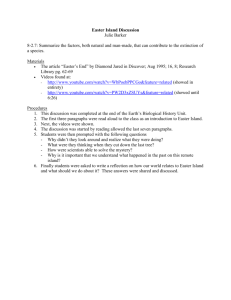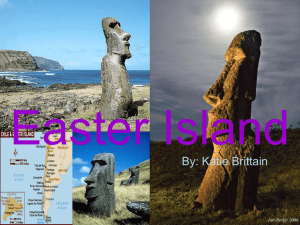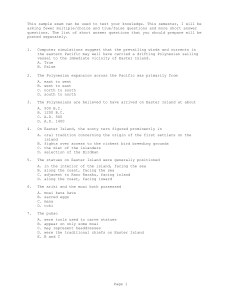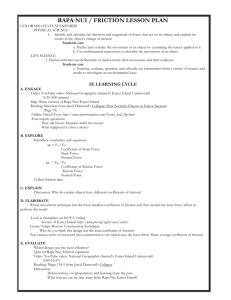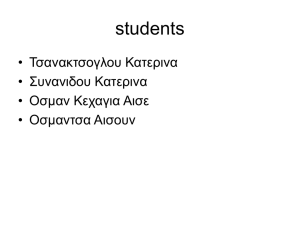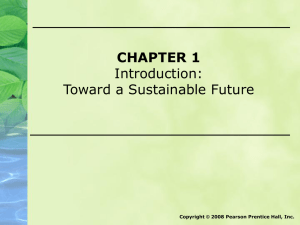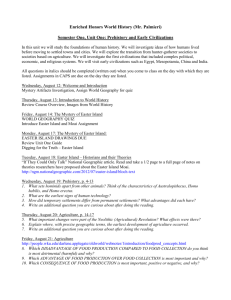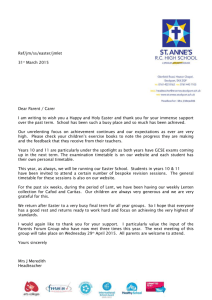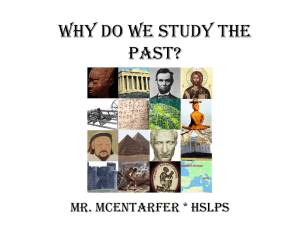File
advertisement
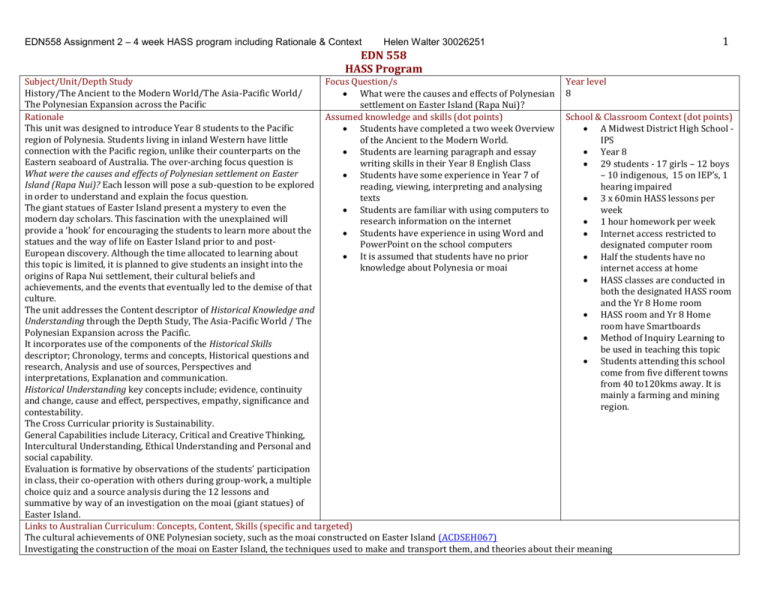
EDN558 Assignment 2 – 4 week HASS program including Rationale & Context Helen Walter 30026251 1 EDN 558 HASS Program Subject/Unit/Depth Study Focus Question/s Year level History/The Ancient to the Modern World/The Asia-Pacific World/ What were the causes and effects of Polynesian 8 The Polynesian Expansion across the Pacific settlement on Easter Island (Rapa Nui)? Rationale Assumed knowledge and skills (dot points) School & Classroom Context (dot points) This unit was designed to introduce Year 8 students to the Pacific Students have completed a two week Overview A Midwest District High School region of Polynesia. Students living in inland Western have little of the Ancient to the Modern World. IPS connection with the Pacific region, unlike their counterparts on the Students are learning paragraph and essay Year 8 Eastern seaboard of Australia. The over-arching focus question is writing skills in their Year 8 English Class 29 students - 17 girls – 12 boys What were the causes and effects of Polynesian settlement on Easter – 10 indigenous, 15 on IEP’s, 1 Students have some experience in Year 7 of Island (Rapa Nui)? Each lesson will pose a sub-question to be explored reading, viewing, interpreting and analysing hearing impaired in order to understand and explain the focus question. texts 3 x 60min HASS lessons per The giant statues of Easter Island present a mystery to even the week Students are familiar with using computers to modern day scholars. This fascination with the unexplained will research information on the internet 1 hour homework per week provide a ‘hook’ for encouraging the students to learn more about the Students have experience in using Word and Internet access restricted to statues and the way of life on Easter Island prior to and postPowerPoint on the school computers designated computer room European discovery. Although the time allocated to learning about It is assumed that students have no prior Half the students have no this topic is limited, it is planned to give students an insight into the knowledge about Polynesia or moai internet access at home origins of Rapa Nui settlement, their cultural beliefs and HASS classes are conducted in achievements, and the events that eventually led to the demise of that both the designated HASS room culture. and the Yr 8 Home room The unit addresses the Content descriptor of Historical Knowledge and HASS room and Yr 8 Home Understanding through the Depth Study, The Asia-Pacific World / The room have Smartboards Polynesian Expansion across the Pacific. Method of Inquiry Learning to It incorporates use of the components of the Historical Skills be used in teaching this topic descriptor; Chronology, terms and concepts, Historical questions and Students attending this school research, Analysis and use of sources, Perspectives and come from five different towns interpretations, Explanation and communication. from 40 to120kms away. It is Historical Understanding key concepts include; evidence, continuity mainly a farming and mining and change, cause and effect, perspectives, empathy, significance and region. contestability. The Cross Curricular priority is Sustainability. General Capabilities include Literacy, Critical and Creative Thinking, Intercultural Understanding, Ethical Understanding and Personal and social capability. Evaluation is formative by observations of the students’ participation in class, their co-operation with others during group-work, a multiple choice quiz and a source analysis during the 12 lessons and summative by way of an investigation on the moai (giant statues) of Easter Island. Links to Australian Curriculum: Concepts, Content, Skills (specific and targeted) The cultural achievements of ONE Polynesian society, such as the moai constructed on Easter Island (ACDSEH067) Investigating the construction of the moai on Easter Island, the techniques used to make and transport them, and theories about their meaning EDN558 Assignment 2 – 4 week HASS program including Rationale & Context 2 Helen Walter 30026251 Program Week 1 Link to AC skills/content/ concepts Historical Knowledge & Understanding The cultural achievements of the Rapa Nui including the building of Moai Stage of Inquiry Teaching and Learning Activities Resources Evaluation Tuning In 1.1 What do we know about Easter Island? Where is Easter Island? Start lesson by showing an image of the moai or giant statues of Easter Island. Ask students if they can identify what the image is of, and lead into a discussion of what the students know about Easter Island. Their ideas and knowledge to be written up on the whiteboard as a table of What do we know? and What do we want to find out? Students to copy this down into their workbooks. Use Google Earth to take students on a fly-over sight-seeing tour of Easter Island Mapping Exercise – The Polynesian Triangle & Easter Island Pair and share with 1 student completing a map of the Polynesian Triangle and the other completing a map of Easter Island. The students will be given blank maps of each and a list of island names and important geographic features to label. Whiteboard, Whiteboard markers, Whiteboard eraser Interactive whiteboard & computer A3 laminated image of moai Blank map of Polynesian Triangle from http://nztec.victoria.ac.nz with a list of the place names. Blank outline map of Easter Island & list of features http://www.google.com/earth/index.html Class set of atlases and detailed maps of Polynesian Triangle & Easter Island as a reference Coloured pencils or textas Student workbooks ========================== National Geographic Islands and People article sourced from http://education.nationalgeographic.com/ education/encyclopedia/island A3 laminated images of Hokule’a sourced from http://www.exploratorium.edu/neverlost / A3 laminated images of drawings of Easter Islanders by early European visitors Blank timeline worksheet Prepared handout on the European discoverers/visitors to Easter Island sourced from http://www.onthisdeity.com/europeans_d iscover_easter_island/ ============================= Whiteboard etc Pearson Year 8 History textbooks– class set of texts pp 232-233 PPT slideshow of moai images Illustrated handout sheet adapted from http://www.easterislandquest.com/moai. html and http://www.chileculture.org/easterisland-statues-moai/ Interactive whiteboard & computer Resource materials from http://cyark.org/projects/rapa- Formative: observation of student engagement with the set tasks, contribution to discussion topics, and working with others Finding out ========== Inquiry Question What were the causes and effects of contact between societies in this period? Historical Concept Cause & Effect Historical Skill Sequence historical events, developments and periods. ========= Historical Knowledge & Understanding The cultural achievements of the Rapa Nui including the building of Moai ========== Finding Out Gathering information Sorting out ========== Finding out Gathering information Going further 1.2 When was Easter Island settled and by whom? When did Europeans first discover Easter Island? Ask students for their ideas on who the first Easter Island settlers were and how they arrived. Show images of Hokule’a, the great replica Polynesian voyaging canoe. Read as a class the National Geographic article Islands and People. Start a Glossary of Rapa Nui terms on the whiteboard. Students to copy the glossary into their workbooks as a table to be added to in future lessons. Read a class handout about the European visitors to the island from 1722 onwards. Discuss as a class the observations made by Roggeveen, Gonzales and Cook about the moai and the island features and population. What was the effect of European discovery on the islanders? As a class create a timeline on the whiteboard to show the sequence of events from the first arrivals on Easter Island in 700 CE, the arrival of the first Europeans in 1772 until the annexation by Chile in 1888. Students then complete the timeline worksheet and glue it into their workbooks. 1.3 Investigate the construction of the moai or giant statues. Read as a class p232-233 of Pearson 8 History section on Moai. Read illustrated class handout sheet on moai materials and types. Show PPT slideshow of moai. Write up as a list on the whiteboard the materials used and the different types of moai – ahu, moai and moai with pukoa (hats or topknots), the eyes of moai. Add these terms to Glossary. Use the interactive whiteboard lesson materials from CyArk to view a map of the island and investigate the features of selected Rapa Nui moai using the 3D viewer. Students to complete a data sheet on selected moai with name and facts Formative: completion of Polynesian Triangle & Easter Island maps ================ Formative: observation of student engagement with the set tasks and contribution to discussion topics and Glossary Formative: completion of Easter Island timeline ================ Formative: observation of student engagement with the set tasks and contribution to discussion topics EDN558 Assignment 2 – 4 week HASS program including Rationale & Context Finding out 2 Historical Skills Use evidence from sources to support historical narratives and explanations Historical Concept Contestability =========== Inquiry Question What key beliefs and values emerged and how did they influence societies? Gathering Information Sorting out Gathering Information Communicati ng Historical Skill Identify the motives and actions of people at the time Historical Concepts Empathy Perspectives Evidence 2.1 The Moai were made long before modern methods of lifting and transport. How were moai moved around Easter Island? Start by asking students for their ideas about how the statues might have been moved. Write up suggestions on the whiteboard. Discuss some of these theories and show some images of the different methods. Read as a class the handout sheet on different moving theories. Play YouTube clip (1 minute) of animation of how the statues moved. Play audio podcast (12 minutes) from National Geographic about the latest theory on the movement of the statues. Accompany the audio with a visual slideshow of moai images. Play Youtube clip (1 minute) from National Geographic of the scientists' re-creation of the statue ‘walking’. Students to discuss and create a Plus Minus Interesting chart on the whiteboard for the theory that the moai ‘walked’. Copy this into their workbooks and draw sketches in their workbooks of moving the moai. Commence viewing of BBC video Easter Island Mysteries of a Lost World in 15 minute segments over the next 4 lessons as it’s an hour long and some students have poor concentration spans. ========== Historical Concept Contestability ============ Helen Walter 30026251 ========== Gathering information Going Further 2.2 What are some of the theories about the meaning of the moai? Why were they destroyed by the islanders? Divide students into groups of 4 to brainstorm their theories of the meaning of the moai. Provide a large sheet of butcher’s paper for each group to draw a web map or concept map of their theories. Discuss some of the theories about the meaning of the moai (eg: representations of dead ancestors or chiefs) with the students. Class handout sheet of some theories to be read as a group. All of the moai were toppled by the islanders. Several theories to be presented on PPT slideshow together with information on environmental issues. Any new terms to be added to the Glossary. Continue viewing of BBC video Easter Island Mysteries of a Lost World (15 mins) 2.3 Imagine you are a Rapa Nui islander in 1722. What were your living conditions like? Who were your Gods? What was your reaction to the arrival of a strange ship with white men on it? Were you frightened or angered by the strangers, or welcoming of them? How did you communicate? Revisit the information in lesson 1.2 extending the information provided by the European visitors to Rapa Nui by viewing PPT summary of ships logs information about the islanders from Roggeveen. Students in groups of 4 to brainstorm on butcher’s paper and then role-play this scenario for the rest of the class. Continue viewing of BBC video Easter Island Mysteries of a Lost World (15 mins) nui/overview Data sheet templates adapted from http://www.achistoryunits.edu.au/verve/_ resources/htaa_year8_Angkor_angkorpedi a_research_template.pdf Whiteboard etc. Interactive whiteboard YouTube, slideshow images and podcast resources from http://ngm.nationalgeographic.com/2012 /07/easter-island/blochtext?source=news_easter_island_story Coloured pencils or textas Student workbooks Handout sheet of Moai moving theories from http://pbs.org/wgbh/nova/easter/move/ past.html YouTube video BBC Easter Island Mysteries of a Lost World. ================================ Whiteboard etc. Interactive whiteboard Butcher’s paper Coloured pencils/ textas Handout sheets on theories of meaning of the moai and why they were destroyed sourced from http://www.easterislandtourism.com/east er-island-blog/the-easter-island-heads/ and http://www.newworldencyclopedia.org/e ntry/Moai Teacher provided PPT presentation on the environmental issues of living on Easter Island and deforestation prior to 1722 ================================ Interactive whiteboard Butcher’s paper Coloured pencils/ textas PPT slides with information from ships log of Roggeveen sourced from http://easterislandtraveling.com/easterisland-facts-and-info/history/ship-logsand-journals/jacob-roggeveen-1722/ 3 Formative: observation of student engagement with the set tasks and contribution to discussion topics ============== Formative: observation of student engagement with the set tasks, contribution to discussion topics, and working with others in a cooperative group ================ Formative: observation of student engagement with the set tasks, contribution to discussion topics, and working with others in a cooperative group EDN558 Assignment 2 – 4 week HASS program including Rationale & Context Finding out 3 Inquiry Question Which significant people, groups and ideas from this period have influenced the world today? Gathering Information Finding out Gathering Information Sorting Out Historical Concepts Perspectives Evidence Cause & Effect Ethical understanding Gathering Information Reflecting =========== ========== Historical Skills Use evidence from sources to support historical narratives and explanations Gathering information Sorting out ========== Gathering Information Sorting out 4 Helen Walter 30026251 3.1 Introduction to Investigation assignment on the moai. Students are required to complete an Investigation assignment on the Moai of Rapa Nui. This is to be presented as a poster. Students may prepare their work on the computer, print off their text and illustrations, cut them out and glue onto A2 coloured card (provided for each student at a later lesson). The poster must include a title and the student’s name. Students may choose to investigate one or more aspects of the moai Materials, size, construction methods & tools used to make moai How the moai were moved – 2 different theories The meaning of the moai – what did they represent, why were some on platforms, why did some have “hats” and why were they toppled or destroyed Restoration of the moai since the 1980’s including those damaged by the tsunami in 1960 Moai in museums around the world and how they are assisting the research and conservation of moai on Rapa Nui On a separate sheet of paper the students must provide a reference list or bibliography of the sources they used for their information. Students will be given two in-class lessons to research, plan, layout and present their assignment, plus homework time. Allow time for students to ask questions about the assignment. Discuss location of resources for research – Library Books, Encyclopaedias, Internet. Handout sheet of suggested websites and books in the school library to be given to each student, along with the bibliography framework template for recording the resources used. Removal of moai from Easter Island Teacher led presentation of information about moai that are in collections of Museums around the world, specifically the British Museum (Hoa Hakananais), the Smithsonian Museum of Natural History, and the Musee du quai Branly (Paris) plus others. Multiple choice and short answer quiz on about moai that are in collections of museums around the world. Opinion “ethics” question -“Is it right for museums around the world to have moai in their collections?” Students to write a short answer justifying their reasons for why they think this. To be completed in class. Completion of viewing of BBC video Easter Island Mysteries of a Lost World (15 mins) Printed copy of the investigation assignment task for each student Printed copy of Assessment Rubric for each student Bibliography Framework template sourced from http://www.globaleducation.edu.au/resou rces-gallery/resource-gallerytemplates.html 3.2 Research period in the Computer Room Students are to commence their research into their chosen aspect of the moai. Any new terms for the Glossary to be given to the teacher Computer room to be booked prior to the lesson 3.3 Research period in the Computer Room Students are to complete their research into their chosen aspect of the moai and commence layout of their assignment on A2 coloured poster card. Any new terms for the Glossary to be given to the teacher Computer room to be booked prior to the lesson A2 coloured card Handout sheet of suggested resources – websites, library books PPT slideshow on moai in museums around the world. Sourced from http://www.britishmuseum.org/explore/o nline_tours/museum_and_exhibition/audi o_description_tour/hoa_hakananaia.aspx And http://www.mnh.si.edu/onehundredyears /featured_objects/easter_island_stone_figu re.html And http://www.eisp.org/category/archaeolog y/museumobjects/ Multiple Choice & short answer quiz sheets prepared by teacher from above sources Formative: observation of student engagement with the set tasks. Formative:Multiple Choice & short answer quiz Summative task explained. (Task specifications and assessment rubric on a separate page) =============== Formative: observation of student engagement with the set tasks. Observation of students’ skills at searching for and processing of information on the internet Formative: - multiple choice and short answer quiz ============================ ============================= ================ Formative: observation of student engagement with the set tasks. Observation of students’ skills at searching for and processing of information on the internet EDN558 Assignment 2 – 4 week HASS program including Rationale & Context 4 Historical Skills Analysis and use of sources Sorting out Communicati ng =========== ========= Historical Skills Use a range of communication forms (oral, graphic, written) to communicate about the past. =========== Inquiry Question Which significant people, groups and ideas from this period have influenced the world today? Communicati ng Reflecting ========== Going further Reflecting Acting Historical Knowledge & Understanding Theories of the decline of Rapa Nui, such as deforestation and unsustainable practices. Historical Skills Explain the causes and effects of events and developments Helen Walter 30026251 4.1 Source Analysis on moai Students to complete an in-class source analysis task on the moai. Following this task, students can complete the layout of their assignment on A2 coloured poster card and hand it in to the teacher for assessment. More terms for the Glossary to be added to list. 4.2 Presentation of posters to the class By selection of "drawing names out of a hat" 8 students are to make a brief presentation of their poster to the class stating what aspect of the moai they researched and one fact that they found interesting. All posters then to be spread out on display with a separate sheet of paper for 1 positive anonymous comment to be written by each of the other class members about each poster. Allow 10 minutes for students to browse the posters and write their comments. After this, draw another 8 names "out of the hat" and those students are to collect their posters and read out the positive feedback from their peers. Allow reflective group discussion on the posters and the feedback process. Posters are to be retained by the teacher for final assessment. 4.3 Reflection on decline of Rapa Nui society and legacy of the Moai The collapse of Easter Island society has been portrayed as an example of what could happen on a global scale if countries and economies continue to destroy their natural environments and habitats with overpopulation and unsustainable practices. View a YouTube video (11 mins) of a theory of the collapse of Easter Island's economy through deforestation Teacher presents other possible explanations for Easter Island's decline. Students to consider these on a handout sheet and rank them from most to least plausible, justifying their ranking Class to discuss how the environment has shaped human history and how humans have affected the environment. In groups of 4, students rewrite the history of Easter Island by posing "what if" questions by means of a concept map on butcher's paper What if the moai had never been built? What if the trees had not all been destroyed? Students may devise their own "what if" questions. Groups then present their revised history of Easter Island to the rest of the class for discussion and reflection. Final presentation of the Rapa Nui Glossary by teacher, using the terms learned over the past 4 weeks and contributed to by the class. Glossary given out to the students as a small booklet. Reflective class discussion about this learning journey. 5 Source analysis test from Pearson History 8 teacher resource A2 coloured card Summative: – Source analysis task, worth 15 marks =============================== Container with each student's name on a separate piece of paper (raffle ticket style) Summative: Investigation of the moai poster worth 50 marks. (task specifications and assessment rubric on a separate page) ================ Formative: observation of student engagement with the set tasks, contribution to discussion topics, and working with others in a cooperative group A4 sheets of paper with each student's name to be attached to their poster for positive comments / feedback on their posters by other class members. =============================== Whiteboard etc Interactive whiteboard https://www.youtube.com/watch?v=gfbQ A-Krx9Q Lessons from the Past - Easter Island Handout sheet with table of possible explanations for Easter Island's decline with columns for ranking most to least plausible and why. Butcher's paper Prepared Glossary booklet for each student ================ Formative: observation of student engagement with the set tasks, contribution to discussion topics, and working with others in a cooperative group
